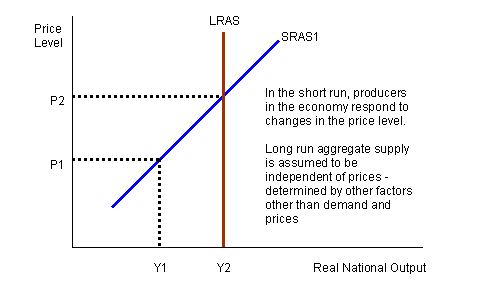The level of real GDP (GDPr) that firms will produce at each price level (PL)
Real GDP= Out put
Long run v Short run AS
Long Run
- period of time where input prices are completely flexible and adjustments to change in the price level
- in the Long run, the level of real GDP supplied is independent of the price level
Short Run
- period of time when input prices are sticky and do not adjust to changes in the price level
- in the Short-run, the level of real GDP supplied is directly related to the price level
Long Run Aggregate Supply (LRAS)
- the long run aggregate supply or in the economy (analogous to ppc)
- Because input prices are completly flexible in the long-run changes in the price level do not change firm's real profits and therefore. do NOT Change firms level of full employment
Short Run Aggregate Supply (SRAS)
- Because input prices are sticky in the short run, in the SRAS is upward sloping
- an increase in GDPr, a decrease goes to the right and left
- The key to understand shifts in SRAS is per unit cost of production.
total input/ total output = per unit cost of production
Changes in SRAS (decreases)
Determinants of SRAS (all following affect production cost)
- input prices
- productivity
- legal-institution environment
Domestic Resource Prices
- Wages (75% of all business cost)
- Cost of capital
- Raw material (commodity prices)
- Strong $ = lower foreign resources prices
- Weak $ = higher foreign resources pries
- -Monopoly and cartels that control resources
- Increases in resource prices in= SRAS shifts <-
- Decreases in resource prices= SRAS shifts ->
productivity = total out put/ total input
- more productivity= lower unit production cost = SRAS shifts ->
- lower productivity = higher unit production cost= SRAS shifts <-
- Taxes ($ to gov't) on business increase per unit production cost = SRAS shifts <-
- Subsides ($ form gov't) to business reduce per unit productivity cost = SRAS shifts ->
- Government regulation creates a cost of compliance = SRAS shifts <-
- Deregulation reduces compliance cost = SRAS shifts ->


No comments:
Post a Comment